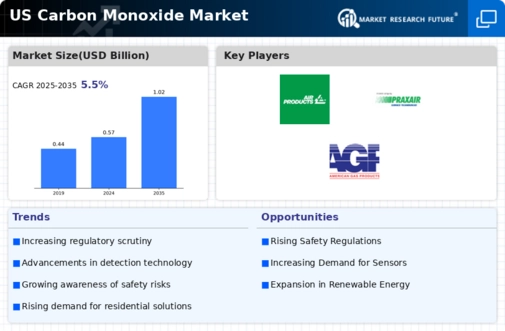Market Share
US Carbon Monoxide Market Share Analysis
In the intricate landscape of the US Carbon Monoxide (CO) Market, companies deploy various market share positioning strategies to establish a strong foothold and gain a competitive advantage. One pivotal strategy involves a focus on safety and regulatory compliance. Given the hazardous nature of carbon monoxide, companies invest significantly in ensuring that their products adhere to strict safety standards and regulations. By emphasizing compliance and promoting the safety features of their carbon monoxide detection systems, businesses aim to build trust among consumers and position themselves as reliable and responsible players in the market.
Product innovation stands out as another key strategy in the US Carbon Monoxide Market. Companies continually invest in research and development to enhance the performance and features of their CO detection devices. This may include advancements in sensor technology, integration with smart home systems, and the development of portable and wireless options. By offering cutting-edge and versatile solutions, businesses can differentiate themselves from competitors and cater to the evolving needs of consumers who prioritize advanced and user-friendly carbon monoxide detection.
Cost leadership is a significant strategy embraced by companies in the US CO Market. This approach revolves around optimizing manufacturing processes, negotiating favorable supplier contracts, and achieving economies of scale. By becoming a low-cost producer, companies can offer competitive pricing for their carbon monoxide detection devices, appealing to a broader consumer base. Cost-effective solutions not only attract price-sensitive customers but also provide companies with a strategic advantage in the market, ensuring sustainability and resilience in the face of market fluctuations.
Market segmentation plays a crucial role in the positioning strategies of carbon monoxide detection device manufacturers in the United States. Recognizing the diverse applications of CO detection, companies tailor their products to cater to specific market segments. This includes devices designed for residential use, commercial and industrial applications, and specialized solutions for sectors such as healthcare or hospitality. Effective segmentation enables companies to target specific customer needs, optimize their market share within niche segments, and respond more efficiently to the unique demands of different industries.
Strategic partnerships and collaborations are instrumental in enhancing market share positioning within the US Carbon Monoxide Market. Companies often collaborate with safety organizations, government agencies, and home automation companies to expand their reach and promote awareness about the importance of carbon monoxide detection. Collaborations can lead to joint educational campaigns, increased product visibility, and the development of integrated safety solutions. Partnering with key stakeholders allows companies to leverage collective strengths, share expertise, and collectively address safety concerns, contributing to increased market share.
Sustainability is becoming an increasingly important aspect of market share positioning in the US Carbon Monoxide Market. Companies are incorporating eco-friendly practices into their manufacturing processes, utilizing recyclable materials, and adopting energy-efficient production methods. Embracing sustainability not only aligns with corporate responsibility goals but also resonates with environmentally conscious consumers. Carbon monoxide detection device manufacturers positioning themselves as environmentally responsible entities can gain favor among customers who prioritize sustainability in their purchasing decisions.
Moreover, a robust digital presence is crucial in today's digital age. Carbon monoxide detection companies in the United States leverage digital marketing, e-commerce platforms, and social media to connect with consumers, raise awareness about CO safety, and facilitate online sales. An effective online presence enables companies to reach a broader audience, provide educational resources, and engage with customers directly, enhancing brand visibility and trust in the competitive carbon monoxide detection market.





Leave a Comment